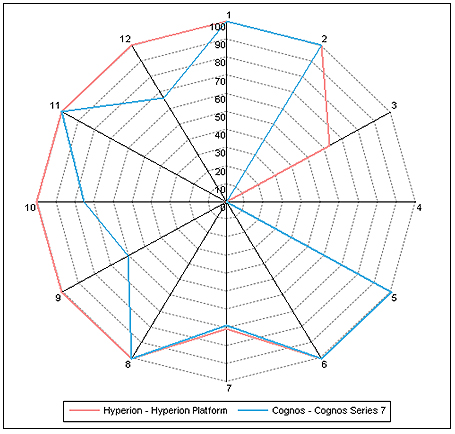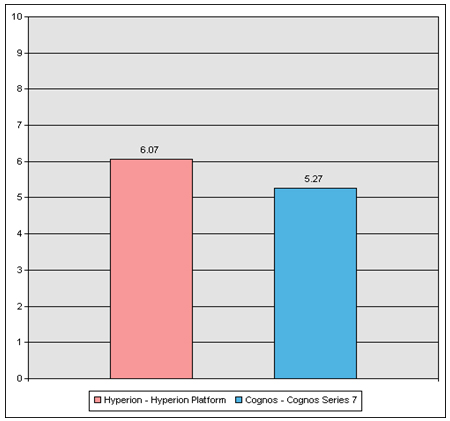White Paper
Section I
Business Intelligence Vendors: Ratings, Capabilities, Analysis & Recommendations.
Description
This complete rating detail report covers the vendor responses to American CITís comprehensive research model. The report answers your concerns about how your chosen vendors will support your requirements.
Rating Guide
| Rating Customization Future Release Modification Not Supported Supported Third Party Support |
Value 40 20 70 0 100 60 |
Description Supported via customization (changes to the source code) Supported in a future release Supported via modification (screen configurations, reports, GUI) Unsupported Supported as delivered out-of-the-box Supported via a third party solution |
Business intelligence (BI) applications enable real time, interactive access, analysis, and manipulation of mission-critical corporate information. Users are able to access and leverage vast amounts of information to analyze relationships and understand trends that, ultimately, support business decisions.
| Business Intelligence Knowledge Tree | Cognos Series 7 |
Hyperion Platform |
| 1. Business Performance Management (BPM) | ||
| 1.1. Functions to Fulfill BPM Needs | ||
| 1.1.1. Financial modeling with real time alternatives strategies producer | Supported | Supported |
| 1.1.2. Creates business models for profitability | Supported | Supported |
| 1.1.3. ROI prediction | Not Supported | Modification |
| 1.1.4. Determines production costs | Not Supported | Supported |
| 1.1.5. Determines production capacity | Not Supported | Supported |
| 1.1.6. Determines activity levels across the enterprise | Not Supported | Supported |
| 1.1.7. Real time simulation for alternative business scenarios | Supported | Supported |
| 1.1.8. Monitors progress metrics continuously and real time | Supported | Supported |
| 1.1.9. Provides alerts to variance between plans and actuals | Supported | Supported |
| 1.1.10. Multilevel access to relevant performance indicator tools | Supported | Supported |
| 1.1.11. Sales matrices for executives | Supported | Supported |
| 1.1.12. Quality matrices for executives | Supported | Supported |
| 1.1.13. Allows using dashboards | Supported | Supported |
| 1.1.14. Translates analyzed outcomes into performance drivers | Supported | Supported |
| 1.1.15. Query and reporting | Supported | Supported |
| 1.2. Customization | ||
| 1.2.1. Capable of building customized BPM applications | Supported | Supported |
| 1.2.2. Dashboard configurable by system administrator | Supported | Supported |
| 1.2.3. Dashboard configurable by system administrator | Supported | Supported |
| 1.2.4. Drag and drop capability | Supported | Supported |
| 1.2.5. Managers can set goals and assign them to groups and individuals | Supported | Supported |
| 1.2.6. Personalized scorecard capability | Supported | Supported |
| 2. Analytics | ||
| 2.1. Sales Analytics | ||
| 2.1.1. Allows access to key sales metrics | Supported | Supported |
| 2.1.2. Qualifies key sales drivers | Supported | Supported |
| 2.1.3. Tracks KPIs (key performance indicators) | Supported | Supported |
| 2.1.4. Monitors KPIs against pre-determined expectation | Supported | Supported |
| 2.1.5. Monitors KPIs against time period | Supported | Supported |
| 2.1.6. Captures data about the whole sales cycle | Supported | Supported |
| 2.1.7. Provides sales alerts | Supported | Supported |
| 2.1.8. Tracks unsold products | Supported | Supported |
| 2.1.9. Tracks inactive customers | Supported | Supported |
| 2.1.10. Tracks product discounting | Supported | Supported |
| 2.1.11. Tracks over- or underperforming areas | Supported | Supported |
| 2.1.12. Forecast future retail sales | Supported | Supported |
| 2.1.13. Presents summarized sales data and allow detailed sales data to be viewed, manipulated, and analyzed | Supported | Supported |
| 2.1.14. Inquiry analysis to provide insight into the initial stage of the sales process | Supported | Supported |
| 2.1.15. Spot cross-sell and up-sell opportunities analysis | Supported | Supported |
| 2.1.16. Analyzes sales orders and all metrics related to it | Supported | Supported |
| 2.1.17. Sales and delivery service analysis | Supported | Supported |
| 2.1.18. Sales functional performance analysis | Supported | Supported |
| 2.1.19. Sales analysis from the customer perspective | Supported | Modification |
| 2.1.20. Sales analysis from the product perspective | Supported | Supported |
| 2.1.21. Sales organizational analysis | Supported | Supported |
| 2.1.22. Leads analysis | Supported | Supported |
| 2.1.23. Product sales analysis | Supported | Supported |
Section II
Capabilities and Recommendations
The following table illustrates the main capabilities of the top vendors that fit the requirements at Cigna.
| Hyperion Platform | Cognos Series 7 |
|
| (1) Industry | ||
| Financial Institutions | Excellent | Excellent |
| Insurance | Excellent | Excellent |
| (2) Annual Revenue | ||
| Over $3 billion in revenues | Excellent | Excellent |
| (3) Number of Employees | ||
| Over 10,000 Employees | Good | Not Competitive |
| (4) Budget Based on Users | ||
| 101 to 200 users for $1,000,000 to $3,000,000 |
Not Competitive | Not Competitive |
| (5) Localization | ||
| North America (Canada and the United States) | Extensive | Extensive |
| (6) Language Support | ||
| English | Yes | Yes |
| (7) Functionality | ||
| Business performance management | Extensive | Extensive |
| Cluster analysis | Strong | Extensive |
| Contact center analytics | Strong | Extensive |
| Customer analytics | Strong | Extensive |
| Electronic profiling | Strong | Extensive |
| Finance analytics | Extensive | Extensive |
| Forecasting | Extensive | Low |
| Human resources analytics | Strong | Extensive |
| Marketing analytics | Strong | Extensive |
| Marketing management | Extensive | Extensive |
| Multivariate analysis | Low | Strong |
| Partner analytics | Strong | Extensive |
| Predictive modeling | Extensive | Not Competitive |
| Product and service analytics | Strong | Extensive |
| Sales analytics | Strong | Extensive |
| Scorecards | Extensive | Adequate |
| Supply chain analytics | Strong | Extensive |
| Text mining | Low | Not Competitive |
| Web mining | Low | Not Competitive |
| Web site analytics | Adequate | Adequate |
| What-if analysis | Adequate | Not Competitive |
| Workflow manager | Low | Not Competitive |
| (8) Structure | ||
| National with over 10 sites, primarily Distribution | Excellent | Excellent |
| (9) Server Platform | ||
| IBM iSeries (AS/400) | Yes | Yes |
| IBM mainframe | Yes | No |
| Novell Netware | Yes | No |
| Unix (such as Solaris or AIX) | Yes | Yes |
| Windows NT/2000/XP | Yes | Yes |
| (10) DBMS Platform | ||
| IBM DB2 | Yes | Yes |
| Microsoft SQL Server | Yes | Yes |
| My SQL | Yes | No |
| Oracle | Yes | Yes |
| (11) Industry Standard | ||
| HTTP | Yes | Yes |
| Microsoft .NET platform | Yes | Yes |
| (12) Customization, Thin-Client Access, and Standards | ||
| There is tight native integration between functional modules. | Extensive | Extensive |
| There is tight native integration between each supported industry standard. | Extensive | Extensive |
| There is flexibility between functional modules (i.e., modules can be implemented incrementally and can be interfaced to third party modules) between each area. | Extensive | Extensive |
| Mobile access to enterprise data in the product offering is available. | Extensive | Extensive |
| There is total portal access to the system, which is role-based and customizable. | Extensive | Extensive |
| There is "rich client" web browser access to the Internet and use of selected system areas. | Extensive | Not Competitive |
| There is HTML (zero client footprint) web browser access to the Internet and selected system areas. | Extensive | Extensive |
| There is a thin-client link to the Internet and selected system areas. | Extensive | Not Competitive |
| There is collaborative sharing of system data, automatic processes and workflow. | Extensive | Not Competitive |
Based on our pre-selection responses, the graph below provides an overview of the relative strengths and weaknesses of the pre-selected vendors. The labels along the outside of the graph represent the corresponding pre-selection question number. The numbers down the middle (ranging from 0-100) represent the vendor's ability to satisfy your needs on a percentage basis.



Based on the answers we predicted and comparing them with the vendors' capabilities, the chart below shows the overall ratings for the top vendors that fit your profile.